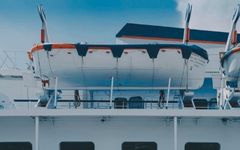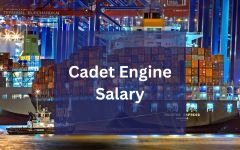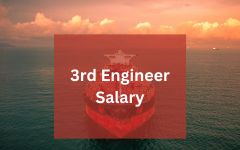Safety Officer in Shipping Duties and Responsibilities
The role of a maritime safety officer is critical to ensuring the safety of crew members, vessels, and the environment in which they operate. A safety officer is responsible for developing and implementing safety policies and procedures, conducting safety audits and inspections, and providing training to crew members.
Duties of a Safety Officer
Develop and Implement Safety Policies and Procedures
Developing and implementing safety policies and procedures is a critical responsibility of a marine safety officer. These policies and procedures are designed to minimize the risks associated with vessel operations and ensure the safety of crew members, passengers, and the environment.
To develop effective safety policies and procedures, the safety officer must first assess the risks associated with various activities at sea. This involves identifying potential hazards, such as rough seas, equipment failure, or human error. The safety officer must also review relevant regulations and guidelines to ensure that all policies and procedures are in compliance.
Once the risks have been identified, the safety officer must develop procedures to mitigate those risks. These procedures should cover all aspects of vessel operations, including navigation, equipment maintenance, and emergency response. The procedures should be comprehensive and detailed, with clear instructions for crew members to follow.
Implementing safety policies and procedures requires the cooperation and participation of all crew members. The safety officer must ensure that all crew members are aware of the policies and procedures and have received the necessary training to implement them effectively. Regular drills and exercises should be conducted to ensure that all crew members are familiar with the procedures and can implement them in an emergency.
In addition to developing and implementing safety policies and procedures, the marine safety officer must also ensure that they are regularly reviewed and updated. This involves monitoring safety incidents and identifying areas for improvement. The safety officer must also stay abreast of changes to regulations and guidelines and ensure that all policies and procedures are in compliance.
Developing and implementing effective safety policies and procedures is critical to the safe operation of vessels at sea. It requires a thorough understanding of the risks associated with vessel operations, as well as knowledge of relevant regulations and guidelines. The safety officer must be proactive in identifying potential hazards and developing procedures to mitigate those risks. Effective implementation of these policies and procedures requires the cooperation and participation of all crew members, and regular review and updating is necessary to ensure their continued effectiveness.
Conduct Safety Audits and Inspections
As a safety officer, conducting safety audits and inspections is an essential duty to ensure that vessels and equipment are in compliance with safety regulations and guidelines. These audits and inspections help to identify potential hazards and risks, allowing the marine safety officer to implement appropriate measures to minimize them.
Conducting safety audits and inspections involves a thorough examination of all aspects of vessel operations, including the condition of equipment, safety procedures, and crew training. The safety officer must ensure that all safety equipment is in good working order and that it is being used correctly. Additionally, the safety officer must evaluate the effectiveness of safety procedures and identify areas for improvement.
During safety audits and inspections, the safety officer must pay close attention to the condition of the vessel's structure, electrical systems, navigation equipment, and firefighting systems. Any issues identified during the audit or inspection must be addressed immediately to minimize the risk of accidents or environmental damage.
Furthermore, the safety officer must ensure that all crew members are properly trained and that they have the necessary skills to respond effectively in an emergency situation. The safety officer must verify that all crew members have received the necessary training and that they are aware of their responsibilities in the event of an emergency.
Conducting regular safety audits and inspections is critical to maintaining a safe and secure working environment on board vessels. The safety officer must be vigilant in identifying potential hazards and risks and take appropriate measures to mitigate them. Regular inspections and audits help to ensure that all equipment and procedures are in compliance with safety regulations and guidelines, minimizing the risk of accidents and environmental damage.
Provide Safety Training to Crew Members
One of the primary responsibilities of a safety officer is to provide safety training to crew members. This training is essential to ensure that all crew members are aware of the potential hazards associated with vessel operations and can respond appropriately in an emergency situation.
Providing safety training to crew members involves identifying the types of hazards that crew members may encounter while at sea. These hazards may include rough seas, equipment failure, fires, and collisions. The safety officer must provide training on how to identify and mitigate these hazards and how to respond in an emergency situation.
The safety training should cover all aspects of vessel operations, including navigation, equipment maintenance, and emergency response. Crew members must be trained on the proper use of safety equipment, such as life jackets and fire extinguishers. Additionally, crew members must be trained on how to respond to emergencies, such as fires, flooding, and medical emergencies.
The safety officer must ensure that all crew members have received the necessary safety training before they begin working on the vessel. The training should be provided in a manner that is easily understandable and accessible to all crew members. Regular refresher training should also be provided to ensure that crew members remain aware of potential hazards and can respond appropriately in an emergency.
Providing safety training to crew members is critical to maintaining a safe and secure working environment on board vessels. The safety officer must be diligent in identifying potential hazards and risks and ensure that all crew members are aware of how to respond in an emergency situation. The training must be comprehensive and cover all aspects of vessel operations to ensure that crew members have the necessary skills to respond effectively in any situation.
Investigate Accidents and Incidents
Investigating accidents and incidents is an important responsibility of a marine safety officer. The purpose of an investigation is to determine the cause of an accident or incident and identify any areas where improvements can be made to prevent similar incidents from occurring in the future.
When investigating an accident or incident, the safety officer must gather all relevant information, including witness statements, photographs, and physical evidence. They must also review any relevant policies and procedures, as well as compliance with safety regulations and guidelines. This information is then used to identify the root cause of the accident or incident.
Once the root cause of the accident or incident has been identified, the safety officer must develop recommendations for corrective actions that will prevent similar incidents from occurring in the future. These recommendations may include changes to policies and procedures, improvements to equipment, and additional training for crew members.
It is important for the safety officer to communicate their findings and recommendations to all relevant stakeholders, including senior management and crew members. This ensures that everyone is aware of the findings and understands the corrective actions that need to be taken.
By investigating accidents and incidents, the safety officer plays a critical role in ensuring the safety and security of vessel operations. The information gathered during the investigation is used to identify areas where improvements can be made, which in turn reduces the risk of future accidents or incidents.
Liaise with Regulatory Agencies
One of the primary responsibilities of a marine safety officer is to liaise with regulatory agencies. These agencies are responsible for ensuring that all vessels comply with safety regulations and guidelines to protect the crew, passengers, and the environment. The marine safety officer plays a critical role in ensuring that the vessel meets all regulatory requirements.
Liaising with regulatory agencies involves staying up-to-date with changes in regulations and ensuring that the vessel is in compliance with all relevant regulations. The safety officer must be familiar with all applicable regulations and guidelines, including those related to navigation, safety equipment, pollution prevention, and crew qualifications.
The safety officer must also communicate with regulatory agencies to obtain necessary permits and certifications for the vessel. This may include permits for the discharge of waste, certification of the vessel's safety equipment, and inspection of the vessel for compliance with safety regulations.
In addition to obtaining necessary permits and certifications, the safety officer must also maintain accurate records and documentation of the vessel's compliance with regulations. This includes maintaining records of safety equipment inspections, crew qualifications, and waste discharge reports.
The safety officer must be able to communicate effectively with regulatory agencies to ensure that the vessel is in compliance with all relevant regulations. They must be able to provide clear and concise information regarding the vessel's compliance status and any necessary corrective actions that have been taken.
By liaising with regulatory agencies, the safety officer plays a critical role in ensuring the safety and security of vessel operations. They ensure that the vessel meets all regulatory requirements and that crew members are trained and equipped to respond to any potential hazards or emergencies.
Responsibilities of a Marine Safety Officer
Ensuring Compliance with Regulations
One of the primary duties of a safety officer is to ensure compliance with regulations. Compliance with regulations is essential to ensure the safety and security of vessel operations and protect the crew, passengers, and the environment. The safety officer plays a critical role in ensuring that the vessel meets all regulatory requirements.
Ensuring compliance with regulations involves staying up-to-date with changes in regulations and ensuring that the vessel is in compliance with all relevant regulations. The safety officer must be familiar with all applicable regulations and guidelines, including those related to navigation, safety equipment, pollution prevention, and crew qualifications.
The safety officer must also ensure that all crew members are trained and qualified to operate the vessel safely and respond to any potential hazards or emergencies. This includes providing training on safety equipment, pollution prevention, and emergency procedures.
In addition to training crew members, the safety officer must also ensure that all safety equipment is properly maintained and inspected. This includes lifeboats, life rafts, firefighting equipment, and navigation equipment. Regular inspections and maintenance ensure that the equipment is in good working order and ready for use in an emergency.
The safety officer must also ensure that the vessel is properly registered and has all necessary permits and certifications. This includes permits for the discharge of waste, certification of the vessel's safety equipment, and inspection of the vessel for compliance with safety regulations.
By ensuring compliance with regulations, the safety officer plays a critical role in ensuring the safety and security of vessel operations. They ensure that the vessel meets all regulatory requirements and that crew members are trained and equipped to respond to any potential hazards or emergencies.
Identifying and Mitigating Risks
One of the crucial duties of a safety officer is to identify and mitigate risks. Identifying and mitigating risks is essential to ensure the safety and security of vessel operations and protect the crew, passengers, and the environment. The safety officer plays a critical role in identifying potential hazards and implementing measures to mitigate them.
Identifying and mitigating risks involves conducting risk assessments to identify potential hazards and implementing measures to mitigate or eliminate them. The safety officer must be familiar with all potential hazards, including those related to navigation, weather, equipment failure, and human error.
The safety officer must also develop and implement safety procedures and protocols to minimize the risk of accidents and incidents. This includes implementing emergency response procedures, conducting drills, and providing training to crew members on how to respond to emergencies.
In addition to developing and implementing safety procedures, the marine safety officer must also ensure that all safety equipment is readily available and in good working order. This includes lifeboats, life rafts, firefighting equipment, and navigation equipment.
The safety officer must also ensure that all crew members are aware of potential hazards and are trained and equipped to respond to them. This includes providing training on safety equipment, pollution prevention, and emergency procedures.
By identifying and mitigating risks, the marine safety officer plays a critical role in ensuring the safety and security of vessel operations. They ensure that potential hazards are identified, and measures are taken to mitigate or eliminate them, minimizing the risk of accidents and incidents.
Monitoring and Evaluating Safety Performance
Monitoring and evaluating safety performance is a crucial responsibility of a safety officer. It involves tracking the vessel's safety performance and identifying areas where improvements can be made to enhance safety and security. This is essential to ensure the safety of crew members, passengers, and the environment.
Monitoring and evaluating safety performance involves collecting and analyzing data on safety incidents and accidents, near-misses, and safety-related issues. The marine safety officer must use this data to identify patterns and trends and develop strategies to address any potential safety issues.
The safety officer must also evaluate the effectiveness of safety procedures and protocols regularly. This includes conducting safety audits and inspections to ensure that all safety equipment is in good working order and that all crew members are trained and equipped to respond to potential hazards and emergencies.
In addition to monitoring safety performance, the marine safety officer must also communicate safety-related information to all crew members. This includes providing regular safety briefings and ensuring that all crew members are aware of potential hazards and how to respond to them.
The safety officer must also ensure that all safety-related documentation is up-to-date and accurate. This includes maintaining records of safety drills and training sessions, safety incidents and accidents, and equipment maintenance and inspections.
By monitoring and evaluating safety performance, the safety officer plays a critical role in ensuring the safety and security of vessel operations. They identify potential safety issues and develop strategies to address them, ensuring that all crew members are trained and equipped to respond to potential hazards and emergencies.
Maintaining Emergency Response Plans
Maintaining emergency response plans is one of the critical responsibilities of a marine safety officer. Emergency response plans are essential for responding to potential hazards and emergencies, ensuring the safety and security of vessel operations and protecting the crew, passengers, and the environment.
Maintaining emergency response plans involves developing and implementing procedures for responding to a range of potential hazards, including fires, collisions, grounding, and oil spills. The safety officer must ensure that all crew members are trained and equipped to respond to these potential hazards.
The safety officer must also ensure that emergency response plans are regularly reviewed and updated to reflect any changes to vessel operations, equipment, or regulations. This includes conducting regular drills and simulations to test the effectiveness of emergency response procedures and protocols.
In addition to maintaining emergency response plans, the marine safety officer must also ensure that all safety equipment is in good working order and readily available in the event of an emergency. This includes lifeboats, life rafts, firefighting equipment, and navigation equipment.
The safety officer must also liaise with regulatory agencies to ensure that emergency response plans comply with all relevant regulations and guidelines. This includes maintaining accurate records of safety drills and training sessions and submitting reports to regulatory agencies as required.
By maintaining emergency response plans, the safety officer plays a critical role in ensuring the safety and security of vessel operations. They ensure that potential hazards are identified, and measures are taken to mitigate or eliminate them, minimizing the risk of accidents and incidents.






